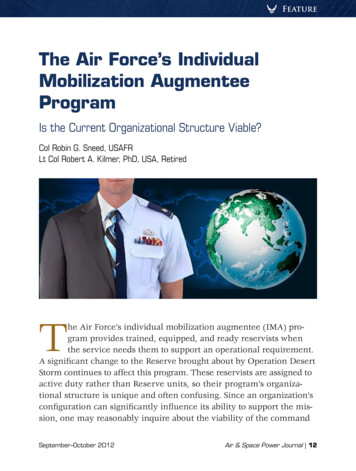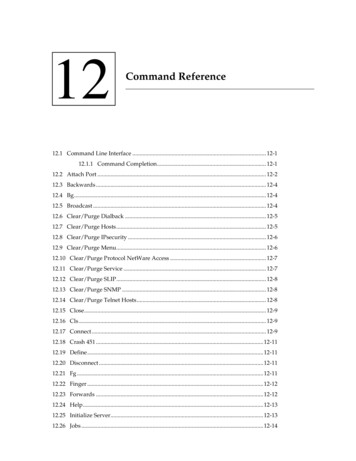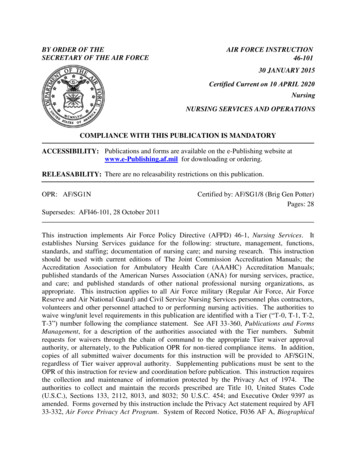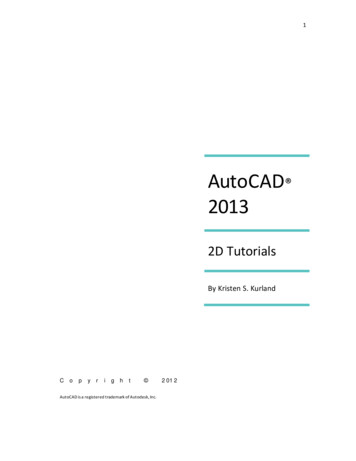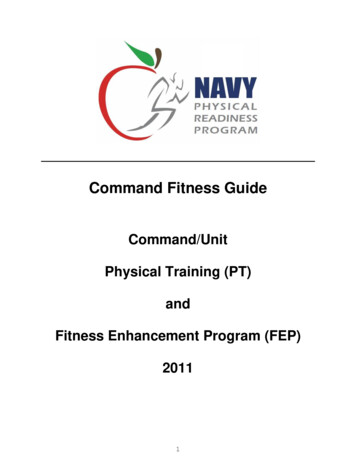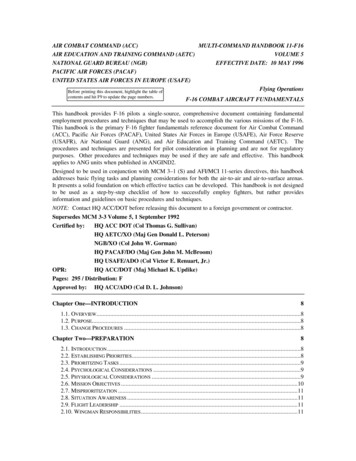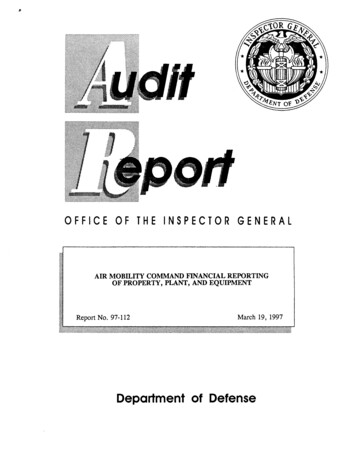
Transcription
OFFICE OF THE INSPECTOR GENERALIAIR MOBILITY COMMAND FINANCIAL REPORTINGOF PROPERTY, PLANT, AND EQUIPMENT1!!!L: } : ;WMDepartment of Defense
Additional CopiesTo obtain additional copies of this audit report, contact the Secondary ReportsDistribution Unit of the Analysis, Planning, and Technical Support Directorate at(703) 604-8937 (DSN 664-8937) or FAX (703) 604-8932.Suggestions for Future AuditsTo suggest ideas for or to request future audits, contact the Planning andCoordination Branch of the Analysis, Planning, and Technical Support Directorateat (703) 604-8939 (DSN 664-8939) or FAX (703) 604-8932. Ideas and requests canalso be mailed to:OAIG-AUD (ATTN: APTS Audit Suggestions)Inspector General, Department of Defense400 Army Navy Drive (Room 801)Arlington, VA 22202-2884Defense HotlineTo report fraud, waste, or abuse, contact the Defense Hotline by calling(800) 424-9098; by e-mailing Hotline@DODIG.OSD.MIL; or by writing theDefense Hotline, The Pentagon, Washington, DC 20301-1900. The identity of eachwriter and caller is fully protected.AcronymsAMCDBOFDFASIGPP&EUSTRANSCOMAir Mobility CommandDefense Business Operations FundDefense Finance and Accounting ServiceInspector GeneralProperty, Plant, and EquipmentU.S. Transportation Command
INSPECTOR GENERALDEPARTMENT OF DEFENSE400 ARMY NAVY DRIVEARLINGTON. VIRGINIA 22202·2884March 19, 1997MEMORANDUM FOR COMMANDER, U.S. TRANSPORTATION COMMANDCOMMANDER, AIR MOBILITY COMMANDDIRECTOR, DEFENSE FINANCE AND ACCOUNTINGSERVICESUBJECT: Audit Report on Air Mobility Command Financial Reporting of Property,Plant, and Equipment (Report No. 97-112)We are providing this report for your information and use. We audited the AirMobility Command's financial reporting of property, plant, and equipment as part ofthe overall audit of the the Defense Business Operations Fund financial statements.Financial statement audits are required by the Chief Financial Officers Act of 1990, asamended by the Federal Financial Management Act of 1994.We considered management comments on a draft of this report in preparing thefinal report. Management comments conformed to the requirements of DoD Directive7650.3 and left no unresolved issues. Therefore, no additional comments are required.We appreciate the courtesies extended to the audit staff. Questions on this auditshould be directed to Mr. James L. Komides, Audit Program Director, or Mr. John K.Issel, Audit Project Manager, at (614) 751-1400. See Appendix C for the reportdistribution. The audit team members are listed on the inside back cover.David K. SteensmaDeputy Assistant Inspector Generalfor Auditing
Office of the Inspector General, DoDReport No. 97-112March 19, 1997· Project No. SFJ-2011.00Air Mobility Command Financial Reporting ofProperty, Plant, and EquipmentExecutive SummaryIntroduction. This is the first in a series of reports from our audit of the Property,Plant, and Equipment Accounts in the FY 1996 Financial Statements of the DefenseBusiness Operations Fund. The Air Mobility Command is a subordinate command ofthe U.S. Transportation Command. In 1987, the Secretary of Defense established theU. S. Transportation Command as a unified command to integrate global air, land, andsea transportation. The Air Mobility Command is the largest component of the U.S.Transportation Command.The Air Mobility Command's mission is to airliftpassengers and cargo for DoD and other authorized users. In FY 1996, the AirMobility Command was expected to generate 2.4 billion in revenue, whichrepresented over half of the U.S. Transportation Command's 4 billion in expectedrevenue. In the beginning balance for FY 1996 Defense Business Operations Fundfinancial statements, the Air Mobility Command reported 1.1 billion of Property,Plant, and Equipment.Audit Objective. The objective of this part of the audit was to determine whether theAir Mobility Command and the Defense Finance and Accounting Service DenverCenter took sufficient action to improve the accuracy of the amounts that the DefenseBusiness Operations Fund financial statements showed for the Air Mobility Command'sproperty, plant, and equipment.Audit Results. The Air Mobility Command and the Defense Finance and AccountingService Denver Center did not take the actions needed to accurately report Air MobilityCommand property, plant, and equipment in the Defense Business Operations Fundfinancial statements. Prior audits had concluded that the property, plant, andequipment accounts were understated by at least 155.5 million, and that 277.6 million was unsupported. The only change that the Air Mobility Commandmade to its accounts in FY 1996 was to record 64.1 million that it had budgeted fordepreciation. Management made no other efforts to adjust the amounts reported. As aresult, the 1.1 billion reported as property, plant, and equipment by the Air MobilityCommand will continue to be materially misstated by as much as 433.1 million;inaccurate financial data may be used to make management decisions; and any furtheruse of the statements will be adversely affected.The recommendations in this report, if implemented, will improve the reliability andusefulness of the Air Mobility Command's financial reporting of its property, plant,and equipment accounts. See Part I for a discussion of the audit results.Summary of Recommendations. We recommend that the Commander, U.S.Transportation Command, and the Commander, Air Mobility Command, inconjunction with the Defense Finance and Accounting Service, take immediate actionto implement the policies, procedures, and controls outlined in DoD 7000.14-R, the"DoD Financial Management Regulation," which are necessary to obtain and maintainfinancial data that accurately reflect the values of its property, plant, and equipment
accounts. We recommend that the Director, Defense Finance and Accounting Service,begin migration to a property accounting system for processing the Air MobilityCommand's financial data on property, plant, and equipment. We also recommend thatthe Director, Defense Finance and Accounting Service, work with the Air MobilityCommand to issue guidance and provide a means of processing the property, plant, andequipment data for the financial statements.Management Comments. Comments were received from the Deputy AssistantSecretary of the Air Force, Financial Operations; the Director, Financial Programs andFinancial Analysis, U.S. Transportation Command; the Comptroller, Air MobilityCommand; and the Deputy Director for Accounting, Defense Finance and AccountingService. Management generally concurred with the recommendations and initiatedactions to improve the Air Mobility Command's financial reporting of property, plant,and equipment. These actions include implementing a property accountability system.The estimated completion date of all actions is January 1998. Management commentswere responsive, and no further comments are required. See Part I for a summary ofmanagement comments and Part II for the complete text of the comments.11
Table of ContentsExecutive Summary1Part I - Audit ResultsAudit BackgroundAudit ObjectiveAir Mobility Command Financial Reporting of Property,Plant, and Equipment234Part II - Additional InformationAppendix A. Scope and MethodologyScope and MethodologyOrganizations and Individuals Visited or ContactedManagement Control ProgramAppendix B. Summary of Prior Audits and Other ReviewsAppendix C. Report Distribution1212121416Part III - Management CommentsDepartment of the Air Force CommentsUnited States Transportation Command CommentsAir Mobility Command CommentsDefense Finance and Accounting Service Comments20222325
Part I - Audit Results
Audit ResultsAudit BackgroundU.S. Transportation Command and Air Mobility Command. In 1987, theSecretary of Defense established the U.S. Transportation Command(USTRANSCOM), Scott Air Force Base, Illinois, as a unified command tointegrate global air, land, and sea transportation during wartime. In 1992, theUSTRANSCOM role was expanded to include a peacetime mission. Thismission is executed through the three transportation components of the MilitaryDepartments: the Army's Military Traffic Management Command (MTMC),Falls Church, Virginia; the Navy's Military Sealift Command (MSC),Washington, D.C.; and the Air Force's Air Mobility Command (AMC), ScottAir Force Base, Illinois. USTRANSCOM exercises overall command of thethree transportation components, but has delegated operational control to eachorganization's commander. USTRANSCOM, MTMC, and MSC are almostexclusively funded from the Defense Business Operations Fund (DBOF).However, AMC receives substantial funds from both DBOF and DoDappropriated funds.The AMC mission is to manage airlift services for DoD. It is the largestcommand within USTRANSCOM. During FY 1996, AMC was expected togenerate 2.4 billion in revenues, or over half of USTRANSCOM revenues of 4 billion.Accounting Records.The official accounting records for AMC andUSTRANSCOM are maintained by the Defense Finance and AccountingService (DFAS) Denver Center, Denver, Colorado. However, the accuracy ofinformation entered into financial systems and reported on financial statementsis the responsibility of AMC and USTRANSCOM. Preparation of financialstatements is the joint responsibility of AMC, USTRANSCOM, and DFAS.Defense Business Operations Fund. In October 1992, the Comptroller, DoD(now the Under Secretary of Defense [Comptroller]), incorporatedUSTRANSCOM into the DBOF. The transportation portion of the DBOF iscalled DBOF-T.AMC Financial Reporting. AMC does not produce a separate set of financialstatements. Its financial information is consolidated into the DBOF-T financialstatements published by USTRANSCOM. The September 30, 1995, trialbalance for AMC DBOF-T operations reflected a total of 1.1 billion inproperty, plant, and equipment (PP&E).2
Audit ResultsAudit ObjectiveThe objective of this part of the audit was to determine whether the AMC andthe DFAS Denver Center took sufficient action to improve the accuracy of theamounts shown in the DBOF financial statements for AMC PP&E. See Part II,Appendix A, for a complete discussion of the scope, methodology, andmanagement controls, and Appendix B for prior audit coverage.3
Air Mobility Command FinancialReporting of Property, Plant, andEquipmentThe AMC and the DFAS Denver Center did not take the necessarycorrective actions to accurately report AMC property, plant, andequipment (PP&E) in the DBOF financial statements. Prior audits hadconcluded that AMC PP&E accounts were understated by at least 155.5 million, and that 277.6 million of the amount reported wasunsupported. The only change that AMC made to its accounts was torecord 64.1 million budgeted for depreciation. Neither AMC nor theDFAS Denver Center had:o issued policy and guidance to direct the efforts of subordinateactivities toward collection of data on each capitalized asset;o developed the specific data needed to report on each capitalasset, such as quantity, acquisition cost, and in-service date; oro established the control process needed to ensure the accuracyand completeness of the financial data collected on PP&E.These actions were not taken because AMC and the DFAS DenverCenter did not collect the necessary information.Also, AMCmanagement stated that until the DF AS Denver Center adopted a newfinancial information system for capital assets, corrective actions couldnot be initiated. DFAS Denver Center personnel told us they intended touse the Defense Property Accounting System to collect and reportinformation on AMC PP&E. Unless the actions needed to improve theaccuracy of PP&E reporting are taken, the 1.1 billion reported asPP&E by AMC will continue to be misstated, inaccurate financial datacould be used to make management decisions, and any further use of thestatements will be adversely affected.Preparation of Financial StatementsFinancial Reporting Requirement. The Chief Financial Officers Act of 1990(Public Law 101-576), as amended by "Federal Financial Management Act of1994," (Public Law 103-356), established requirements for Federalorganizations to submit audited financial statements to the Director, Office ofManagement and Budget. DoD is required by the legislation to preparefinancial statements for substantial commercial functions, revolving funds, andtrust funds of the DoD. Financial statements should provide information toDoD managers and the Congress to use in allocating resources and assessingmanagement performance and stewardship.4
Air Mobility Command Financial Reportingof Property, Plant, and EquipmentPP&E Accounting Guidance. Overall accounting guidance for Federally owned PP&E is the Federal Accounting Standards Advisory Board's Statementof Recommended Accounting Standards No. 6, "Accounting for Property,Plant, and Equipment," September, 1995. This standard defines general PP&Eas assets used to provide goods or services. The standard requires recognitionof those assets by business-type activities (whether or not the assets meet thedefinition of any other category) and requires the depreciation of those assets.DoD has also issued general guidance for financial management of PP&E andbusiness-type activities. The guidance is published in DoD 7000.14-R, the"DoD Financial Management Regulation." General guidance on PP&E is involume 4, "Accounting Policy and Procedures," January 1995. Guidance onbusiness-type activities and how they should recognize PP&E is in volume l lB,"Reimbursable Operations, Policy and Procedures--Defense Business OperationsFund," December 1994.Financial Reporting Responsibility. The acting Comptroller, DoD, in amemorandum titled "Financial Management Responsibilities," September 25,1992, addressed the relationship between DFAS and its clients and theresponsibilities of each organization, including AMC and USTRANSCOM, forfinancial reporting. The memorandum specified that:o each DoD organization is responsible for the accuracy of informationentered into financial systems and reported on financial statements; however,o DFAS is responsible for operating and maintaining financial systemsand preparing its clients' financial statements.DoD 7000.14-R, volume 6, "Reporting Policy and Procedure," chapter 2,"Departmental Financial Reports, Roles, and Responsibilities," February 1996,states that DoD organizations such as AMC are responsible for:o ensuring accuracy, completeness, timeliness, and documentarysupport for all data generated by the customer and input into finance andaccounting systems or submitted to the DFAS for input or recording in thefinance and accounting systems and included in financial reports;o establishing appropriate internal controls to ensure the accuracy ofdata provided to DFAS;o reviewing all reports provided by DFAS to assess the accuracy of thefinancial information being reported; ando reconciling and validating source data for financial transactions.Volume 6, chapter 2, further states that DFAS will ensure that data provided bythe customer (including data input to finance and accounting systems by thecustomer) are accurately and promptly recorded and processed in finance and5
Air Mobility Command Financial Reportingof Property, Plant, and Equipmentaccounting systems. This includes performing designated disbursing andaccounting operations on behalf of the customer and recording the results ofthose operations in a timely and accurate manner.Problems IdentifiedThe AMC and the DF AS Denver Center have not taken the necessary actions,identified by auditors from 1993 to the present, that would enable AMC toaccurately report AMC PP&E in the FY 1996 DBOF financial statements.Prior audits concluded that AMC PP&E accounts were understated orunsupported.Since FY 1993, the Inspector General (IG), DoD, and the Air Force AuditAgency have been unable to determine the fairness of AMC PP&E accounts.Four reports have been issued since FY 1993. The reports have generally statedthat the policies, procedures, and systems either did not exist or did not presentthe data fairly. The reports also indicated that despite the availability of dataneeded for financial control of physical assets, AMC did not use the data tomaintain financial control of assets. Internal controls over assets were notadequate, and accounting personnel did not accurately report or supportbalances for accounts. Specific problems identified in the reports were:o general ledger entries of 277.6 million in capital were not adequatelysupported;o because AMC did not identify and report all facilities, real propertybalances were understated by at least 155.5 million;o the servicing DFAS center did not provide timely guidance oncapitalization of assets;o no system was implemented to capture, report, and support the data;ando appropriate asset data were not obtained prior to the close of the fiscalyear, and established accounts were not used.The Air Force Audit Agency made recommendations to DFAS and AMC toimprove the accuracy of recording and supporting the balances in the PP&Eaccounts by selecting a system and implementing procedures for accuratelycapturing, recording, and supporting asset data. DFAS and AMC managementconcurred with the recommendations and estimated that all corrective actionswould be completed by January 31, 1994. However, DFAS and AMC had notimplemented the recommended actions to improve the reporting of PP&E. SeeAppendix B for a discussion of prior audit coverage.6
Air Mobility Command Financial Reportingof Property, Plant, and EquipmentAMC Financial Reporting ActionsAdjustments Taken in FY 1996. The September 30, 1995, trial balance forAMC DBOF operations reflected a total of 1.1 billion in property, plant, andequipment. The trial balance also reflected 493 million in depreciation; thus,PP&E had a net value of 585 million. The only change that AMC made to itsaccounts in FY 1996 was to record 64.1 million budgeted for depreciation.AMC also did not record the 65 .1 million budgeted in FY 1996 forprocurements of PP&E.Actions Needed. AMC and the DFAS Denver Center had not taken the actionsneeded to obtain accurate financial data for the balance of the AMC PP&Eaccounts.AMC had not issued the necessary policies or instructions,coordinated with its subordinate elements, or taken other actions to obtain therequired financial data on PP&E.Obtaining the financial data would have required a coordinated effort betweenAMC and the DFAS Denver Center. However, there was no evidence that thetwo organizations worked together to obtain the necessary data. Also, theDFAS Denver Center had not developed and provided AMC with a means ofprocessing financial data on PP&E.Attempt to Collect Financial Data. We contacted financial management,logistics, information systems, and civil engineering personnel at AMC todetermine whether any actions were taken to improve PP&E reporting.Since FY 1993, AMC had made two attempts to obtain more accurate financialdata for its PP&E accounts. In FY 1993, AMC began developing a centralizeddatabase of AMC capital assets. However, AMC personnel stated that theDFAS organization serving Headquarters, AMC, had instructed AMC to stopusing the database.Because the local DFAS organization had beendisestablished and other personnel changes had occurred, we could not ascertainwhy AMC was told to stop using the database. AMC and DFAS managementpersonnel told us that DFAS, since it is responsible for financial systemsdevelopment, should provide AMC with a system for reporting PP&E.However, at the time of our audit, DFAS had not provided AMC with a systemthat could be used to more accurately report its PP&E assets.In FY 1995, the AMC Civil Engineering Division began obtaining financialdata on AMC facilities at five sites. However, the data were not obtained asdirected by DoD 7000.14-R. The data were not recorded in the DBOF financialsystem because they were sent to the wrong DFAS office.Discussions With AMC Managers. When we asked AMC managers whymore timely and effective actions had not been taken to improve the reporting ofPP&E, they told us that collecting the data would require extensive effort.Also, they stated that DFAS was responsible for providing a financial reportingsystem for PP&E, and until DF AS did so, AMC would not use its limitedresources to collect the data. In the interim, AMC planned to continue, as inFY 1996, providing the DFAS Denver Center with budgetary data (projected7
Air Mobility Command Financial Reportingof Property, Plant, and Equipmentprocurement and depreciation of capital assets as shown in its budget) to satisfyits financial reporting requirement.DoD regulations do not allow the use of budgetary data rather than actual costdata. Entries to accounts must be based on supported, actual events, such ascalculated depreciation of an item in use. These requirements are in DoD7000.14-R, volume 1, "General Financial management Information, Systems,and Requirements," May 1993, chapter 2, "Conceptual Framework," addendum1, "DoD Financial Management System Principles; chapter 3, "AccountingSystems Conformance, Evaluation, and Reporting," addendum, "KeyAccounting Requirements," No. 5, "Accrual Accounting" and No. 8, "AuditTrails;" and in volume 1lB, chapter 62, "Expenses."Required Data. In order to record PP&E and related depreciation in thefinancial records, DoD 700.14-R (volume llB, chapter 58, "Capital Assets")requires that certain data on the assets be provided to DFAS. For each asset,DFAS needs identification data such as nomenclature, serial number, stocknumber, and type of asset; quantity and acquisition cost or fair market value;any additional costs such as transportation, site preparation, improvements, andrelated costs; acquisition or in-use date; and useful life. Depending on the typeof asset, the useful life may range from 5 to 20 years.At the time of the audit, DFAS Denver Center personnel told us they intendedto use the Defense Property Accounting System to collect and reportinformation needed on AMC PP&E. That decision was made in October 1996,and no formal action had been taken to acquire and use the system. We believethat such action, when taken, will provide the mechanism needed to improve thereliability of the 1.1 billion reported as PP&E by AMC.SummaryWeaknesses in the financial reporting of PP&E have been long-standingproblems for DPAS and for organizations such as AMC and USTRANSCOM,for which DFAS must prepare financial statements. To present financial datafairly, as required by the Chief Financial Officers Act of 1990 and the FederalFinancial Management Act of 1994, DFAS and AMC should coordinate theirefforts to obtain and maintain accurate data on PP&E. DPAS should coordinatewith AMC on proper financial guidance, and AMC should establish internalpolicies and procedures to implement the guidance. Also, DPAS shouldprovide AMC with a mechanism (the Defense Property Accounting System isthe standard DoD property accountability system) for accurate processing ofdata on PP&E and associated depreciation. AMC and DFAS also should jointlyestablish the required internal controls to ensure the accuracy of reportedfinancial information.8
Air Mobility Command Financial Reportingof Property, Plant, and EquipmentRecommendations, Management Comments, and AuditResponse1. We recommend that the Commander, U.S. Transportation Command,and the Commander, Air Mobility Command, in conjunction with theDirector, Defense Finance and Accounting Service Denver Center, takeimmediate steps to improve the reliability of the Air Mobility Command'sreporting of property, plant, and equipment on the financial statements, asoutlined in DoD 7000.14-R, the "DoD Financial Management Regulation."Specifically:a. Direct the Air Mobility Command's subordinate elements togather and report to Headquarters, Air Mobility Command, accurate dataon the property, plant, and equipment assigned to them. Data shouldinclude an item identification, quantity, acquisition cost, additional cost,acquisition or in-use date, and useful life.b. Establish the controls, such as periodic inventories andcomparisons among support documents and financial records, needed toensure the continued accuracy and completeness of financial data onproperty, plant, and equipment.c. Continue to report the lack of accurate data on property, plant,and equipment as a material management control weakness in the DefenseFinance and Accountng Service's annual statement of assurance andinclude a timetable for the completion of corrective actions.Management Comments. The Deputy Assistant Secretary of the Air Force,Financial Operations; the Director, Financial Programs and Financial Analysis,U. S. Transportation Command; and the Comptroller, Air Mobility Command,generally concurred with the recommendations. On Recommendations 1.a. andl.b., management stated that AMC, in conjunction with DFAS, was developingmethodologies to identify all DBOF assets and that an interim method forkeeping PP&E data current will be tested at at least one AMC location. Themethod will then be implemented at each AMC location, with a projectedcompletion date of January 1998. On Recommendation 1.c., AMC plans toconsider the status of the corrective actions taken in response to the audit reportwhen determining whether problems in PP&E financial reporting constitute amaterial weakness to be included in the FY 1997 annual statement of assurance.2. We recommend that the Director, Defense Finance and AccountingService, initiate the procedures needed to begin migration to a propertyaccounting system for processing the Air Mobility Command's financialdata on property, plant, and equipment.9
Air Mobility Command Financial Reportingof Property, Plant, and EquipmentManagement Comments. The Deputy Director for Accounting, DFAS,nonconcurred with Recommendation 2. and stated that AMC is responsible formigrating to a property accountability system. However, the Deputy Directorindicated that meetings were held or planned with AMC to discuss the migrationto the Defense Property Accountability System.Audit Response. Although the Deputy Director for Accounting, DFAS,nonconcurred with the recommendation, the planned actions met the intent ofthe recommendations.3. We recommend that the Director, Defense Finance and AccountingService Denver Center:a. Provide guidance to the Air Mobility Command on theinformation needed to fairly present financial data on property, plant, andequipment.b. Verify that the financial statements reflect the financial data onproperty, plant, and equipment reported by the Air Mobility Command.Management Comments. The Deputy Director for Accounting, DFAS,concurred and stated that guidance on the information necessary to fairly presentfinancial data will be provided to AMC by April 1997. The Deputy Directorfor Accounting also stated that DFAS will ensure that financial statementsaccurately reflect PP&E financial data reported by AMC.10
Part II - Additional Information
Appendix A. Scope and MethodologyScope and MethodologyDuring this part of our "Audit of Property, Plant, and Equipment Accounts inthe FY 1996 Financial Statements of the Defense Business Operations Fund,"we reviewed actions taken by AMC, USTRANSCOM, and DF AS to correctpreviously reported deficiencies in the PP&E accounts in the AMC portion ofthe USTRANSCOM financial statements. We reviewed prior audit reports thataddressed the financial reporting of PP&E for AMC for FYs 1992 through 1994and the character of the reported deficiencies. We also reviewed managementresponses to the reported deficiencies.Additionally, we examineddocumentation and discussed with senior management officials atUSTRANSCOM, AMC, and DFAS the actions taken and planned to correct thedeficiencies.This financial-related audit was conducted from April through August 1996 inaccordance with auditing standards issued by the Comptroller General of theUnited States, as implemented by the Inspector General, DoD. We did not usecomputer-processed data or statistical sampling procedures.Organizations and Individuals Visited or ContactedContacts During the Audit.We visited or contacted individuals andorganizations within the DoD. Further details are available on request.Management Control ProgramBoth USTRANSCOM and AMC reported material weaknesses in financialsystems and controls over PP&E in the annual statement of assurance requiredby the management control program. The Commander, USTRANSCOM, inthe management representation letter to the IG, DoD, which accompanied theFY 1995 financial statements, identified procedural and systemic deficienciesthat could prevent auditors from expressing an unqualified opinion on thefinancial statements. The following deficiencies were identified.o As a result of weaknesses in internal control systems and procedures,depreciation is likely to be computed incorrectly.12
Appendix A. Scope and Methodologyo Property is misstated and not reconciled because systems used byUSTRANSCOM organizations do not always provide complete and accurateinformation.o Reporting entities frequently rely on information from operational andlogistics systems.o Management lacks assurance that source data are accurate.Neither statement provided a plan of action or an estimated date for thecompletion of corrective actions. The weaknesses have been long-standingproblems, and minimal efforts have been made to correct them. Managementrecognized the weaknesses, but had reservations about expending the resourcesneeded to correct them. Resolving the weaknesses will require managementcommitment, resources, and a coordinated effort between USTRANSCOM,AMC, and DFAS.13
Appendix B. Summary of Prior Audits andOther ReviewsSince FY 1993, the (IG), DoD, and the Air Force Audit Agency have beenunable to express opinions on the fairness of AMC PP&E accounts. Thereports have generally stated that policies, procedures, and systems did notexist; and, theref
The AMC and the DF AS Denver Center did not take the necessary corrective actions to accurately report AMC property, plant, and equipment (PP&E) in the DBOF financial statements. Prior audits had . Also, AMC management stated that until the DF AS Denver Center adopted a new financial information system for capital assets, corrective actions .
